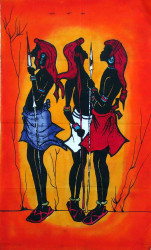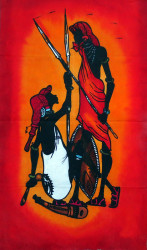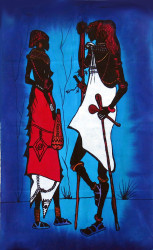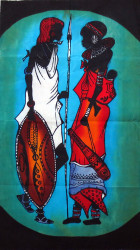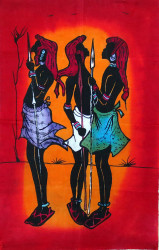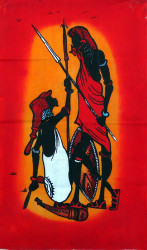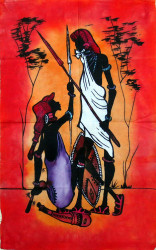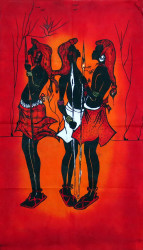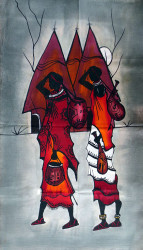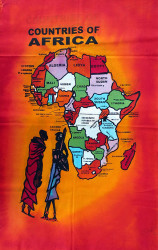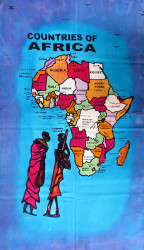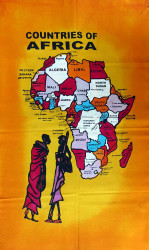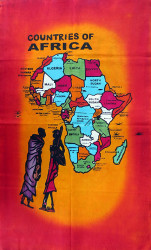These batiks are handmade in Kenya and are of the highest quality available. The maps are all legible and up to date with Africa’s most recent country, South Sudan.
There are different ‘grades’ of batiks from the lowest actually printed on a very light cloth, like a bed sheet – to the highest which use very good quality dyes and strong heavy cloth which absorbs and retains the wonderful colors of the dye. The batiks here are of the highest quality:
Learn more about batiks – scroll down
If you are interested in any African Batiks, you can Make an Offer by using the Contact Page or by emailing me at: todd@insideafricanart.com. Or, better yet, go to the Purchasing Page to make a purchase!
Learn more about Making an Offer
I can get my hands on plenty of these batiks – both the characters as well as the maps. If you are interested in marketing these yourself, I’d be happy to wholesale them to you for a discounted price on order of 50 or more. If you are interested, please let me know!
Things to know: The fold lines that you see on the batiks are actual fold lines. These batiks travel well and on arrival can be lightly ironed on low heat or merely put outside in the sun for a while warm up and settle down. The wrinkles easily disappear with a bit of warmth.
The only thing that batiks don’t like is too much direct sunlight for long durations. If mounted in this condition, in time the vibrant colors will fade. Too many times I see batiks in the storefront of shops and galleries in Nairobi to attract attention – always a mistake, they don’t last long.
The Meaning of the Word Batik
Where does the word ‘batik’ come from? There are several theories on the origins of this craft. The word “batik” is Indonesian in origin. The word batik also occurs in Javanese as Ambatik, which actually means drawing and writing. Batik has evolved around the principle that wax and water repel each other, therefore an area of fabric that has been covered with wax is unable to accept dye. The Indonesian word “tik”, meaning a drop (referring to the small drops of hot wax), shows how the word batik was derived.
The History of Batik
Batik is a very ancient craft dating back at least two thousand years. Batik has been continuously practice in Java for centuries. It was around 1500 that travelers first brought back tales of highly artistic batik fabric on which people worked for months on end. At the close of the last century the technique was introduced to European arts and crafts. Batik has even more enthusiasts today because it produces excellent effects.
It can be defined as a method of applying a colored design on to textiles by waxing those parts that are not to be dyed. Evidence of its practice has been discovered in most Eastern and Middle Eastern countries including India, China, Japan, Persia and Egypt, but although its actual source is unknown, it was on the island of Java in Indonesia that the art reached its peak development. Through the centuries Javanese craftsmen have perfected the art, reflecting the culture and religion of their country in the richness of colors and the detail of the designs on their fabrics. These traditional designs have been passed on from one generation to another and are mainly based on the flora and fauna of their surroundings and this form of expression adapts to society now as easily as it did many years ago. Clothes worked in batik are represented frequently in classical literature of Java. Any mention of magnificent dress always signified batik work. Batik apparel was formerly the clothing of aristocracy. The peasant woman wove the cloth but the lady did the batik. She had time to spare and hers was the gentle hand needed for the work, while the servants attended to the household duties.
Just as the Japanese lady concocts artistic floral arrangements so, even today, the educated Javanese does batik on fabrics, and in this she develops a highly artistic sense. The stylized designs include the native flora, butterflies and birds of paradise. Moreover, these ladies are able to work their individual designs harmoniously into an extensive piece of work.

